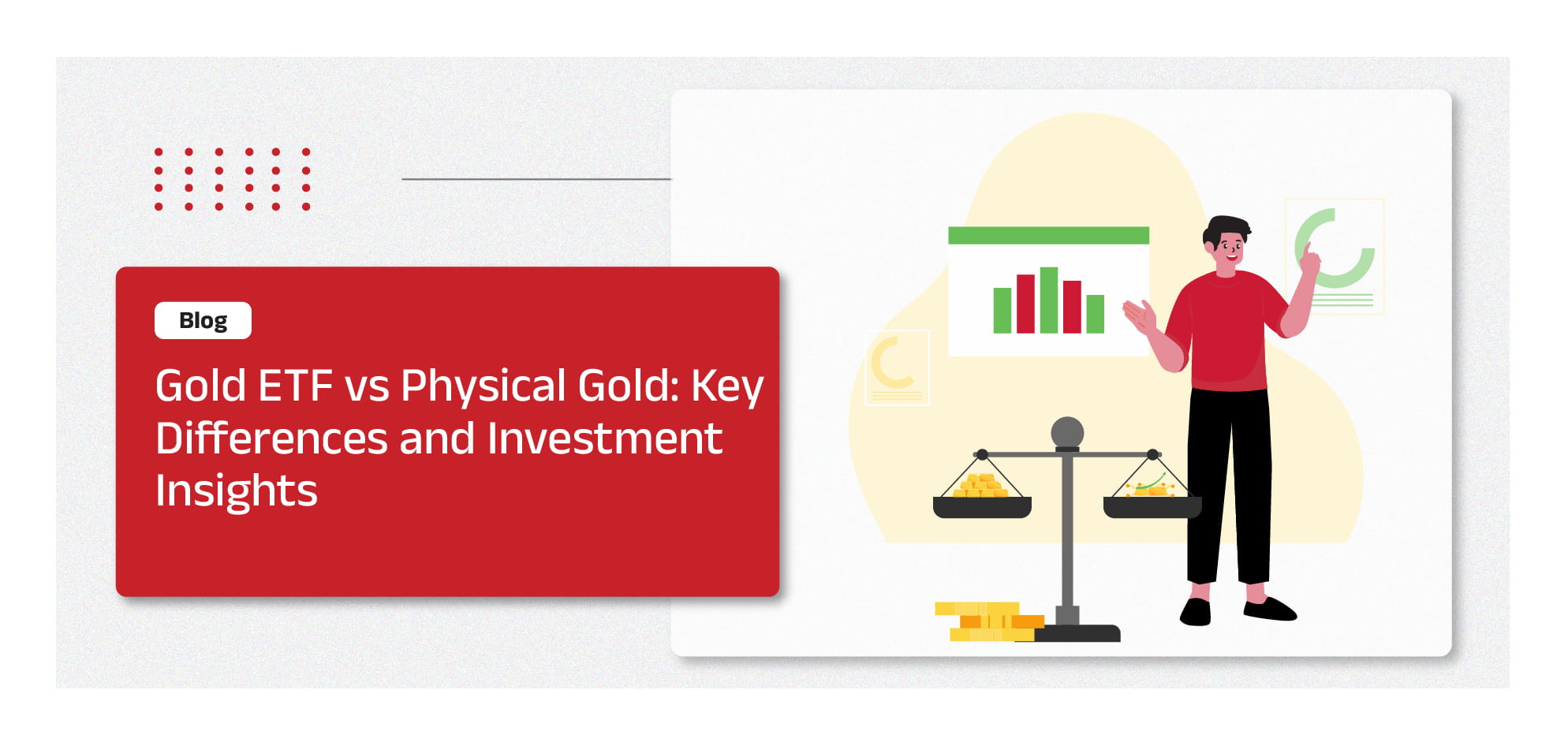-
Our Products
Our FundsFocus Funds
-
Self Care
Self-ServiceFind InformationWays To TransactPartner Solutions
-
Downloads
- Learnings
- About Us
-
More
-
Shareholders
-
Shareholders
-
Updates
-
-
SIP Calculators
- Back
-
Shareholders
Gold ETF vs Physical Gold: Key Differences and Investment Insights

Oct 25, 2025
5 min
0 Rating
Gold has always been more than just a precious metal for Indians.It’s a symbol of security, prosperity, and tradition. From festive gifts to long-term savings, gold holds a special place in Indian households. However, as investment habits evolve and technology advances, the way we invest in gold is also changing.
Today, investors have a choice between physical gold (like jewellery, coins, and bars) and gold traded funds, also known as gold exchange-traded funds(ETFs). These digital options let you invest in gold without actually owning the metal physically. In 2025, when convenience, safety, and liquidity are top priorities, the question arises:Gold ETF Vs Physical Gold: Which is better?
Benefits of Investing in Gold ETFs
Gold ETFs are mutual fund schemes that invest in physical gold on behalf of investors. Each unit of a gold ETF usually represents one gram of gold, and its value moves in line with domestic gold prices.
As per SEBI’s circular on Gold and Silver ETFs, these funds must invest at least 95% of their assets in physical gold or related instruments, ensuring they closely track gold’s performance in the Indian market.
Here’s why they are increasingly preferred in 2025:
High Liquidity
Gold ETFs are traded on stock exchanges just like shares. You can buy or sell them anytime during market hours at the current market price. There’s no waiting period or price negotiation like in physical gold.
Transparent Pricing
The Net Asset Value (NAV) of gold ETFs is updated daily, reflecting real-time gold prices. This ensures that you always know the exact value of your investment.
Safety and Purity
The underlying gold in ETFs must comply with global standards such as the London Bullion Market Association (LBMA) purity norms (99.9% purity). This means you never have to worry about adulteration or substandard gold.
Cost-Efficient
Since gold ETFs are stored electronically, there are no locker fees, insurance charges, or making costs. The only expense is a small management fee (Total Expense Ratio), usually much lower than the hidden costs of physical gold.
Regulated and audited
According to SEBI norms, the physical gold backing ETF units are verified by auditors every six months. This ensures transparency and investor protection: something physical gold cannot guarantee.
Limitations in Physical Gold
While buying physical gold feels familiar, it comes with several practical challenges in today’s modern investment environment.
Storage and Safety
Keeping physical gold safe is not easy. Whether stored at home or in a locker, it always carries the risk of theft or loss. Even with lockers, you pay annual fees that slowly add up over time.
Purity Concerns
Not all physical gold meets purity standards. Even a small deviation from the 24-karat mark can reduce the metal’s resale value. Buyers often depend on jewellers for certification, but in some cases, the quality may vary.
Making and Wastage Charges
Jewellery purchases attract making and wastage charges, which can go as high as 10–15% of the total cost. When you sell it, you rarely recover this amount. Thus, while emotional value remains, financial returns can suffer.
Liquidity Limitations
Selling physical gold can take time, as prices differ between buyers, and you may not get the market rate. During emergencies, finding a quick buyer who offers a fair price can be difficult.
In 2025, when transparency and efficiency define smart investing, these drawbacks push many investors to explore gold exchange-traded funds instead.
Cost Comparison Between ETFs and Physical Gold
In 2025, the cost difference between gold ETFs and physical gold has become even more noticeable.
Parameter |
Gold ETFs |
Physical Gold |
Storage |
No physical storage required |
Locker or home storage needed |
Safety |
Fully secure (held in demat form) |
Risk of theft or loss |
Purity |
99.9% purity (LBMA standard) |
Depends on the jeweller |
Liquidity |
Can sell anytime on the exchange |
Selling depends on the market/jeweller |
Pricing Transparency |
NAV updated daily |
Subjective pricing by the seller |
Taxation |
Treated as a non-equity asset (similar to physical gold) |
Same as gold ETFs |
When you look at total costs over the long term, gold ETFs clearly have an edge.They are easier to manage, more transparent, and cost significantly less to maintain.
Investor Suitability in 2025’s Market Scenario
The Indian investor profile is changing rapidly. Millennials and Gen Z investors may prefer assets that align with their lifestyle. At the same time, older generations are also warming up to the convenience of online investing.
Here’s who might prefer each:
Choose Gold ETFs if
You want to invest purely for returns, not personal use.
You prefer digital convenience and safety.
You value liquidity and transparency.
You want to diversify your portfolio with minimal hassle.
Choose Physical Gold if:
You’re buying jewellery or gifting.
You value emotional and traditional significance over investment performance.
In short, for investment purposes, gold ETFs are the smarter choice in 2025. They offer all the benefits of gold ownership without the physical burdens.
Building Financial Security with Smarter Gold Choices
Gold will always hold its place as a safe-haven asset, but how you invest in it can make all the difference. In 2025, physical gold vs gold ETF India is not a debate of sentiment but of practicality.
With gold exchange-traded funds, you gain access to a modern, transparent, and regulated way of investing in gold. They eliminate the risks of purity, storage, and high transaction costs, all while keeping your money liquid and accessible.
For most investors seeking returns, safety, and flexibility, gold ETFs are redefining how India invests in its most trusted asset:Gold.
Disclaimers:
The information herein is meant only for general reading purposes and the views being expressed only constitute opinions and therefore cannot be considered as guidelines, recommendations or as a professional guide for the readers. The document has been prepared on the basis of publicly available information, internally developed data and other sources believed to be reliable. Recipients of this information are advised to rely on their own analysis, interpretations & investigations. Readers are also advised to seek independent professional advice in order to arrive at an informed investment decision
Mutual Fund investments are subject to market risks, read all scheme related documents carefully.
Yes, gold ETFs can be pledged as collateral with many financial institutions, just like shares or mutual fund units.
There is no fixed large minimum. You can start with just one unit of a gold ETF, usually equivalent to one gram of gold, making it affordable for every investor.





 1800-270-7000
1800-270-7000



